What’s to do in Waimate?
Firstly, Where is Waimate?
Located in Canterbury, Waimate is not on the main highway but situated just inland from the eastern coastline. It’s a short detour west of SH1, 45 km south of Timaru. It’s not a large metropolis but this town has many services that meet the needs of the surrounding districts that border the agriculturally rich Canterbury Plains.
Where We Stayed
We had read some great things about the NZMCA Park in Waimate (TD#8209) so we were keen to go and check it out. It’s located close to the town centre so it’s an easy walk or bike ride to get to the shops and other attractions in the town.
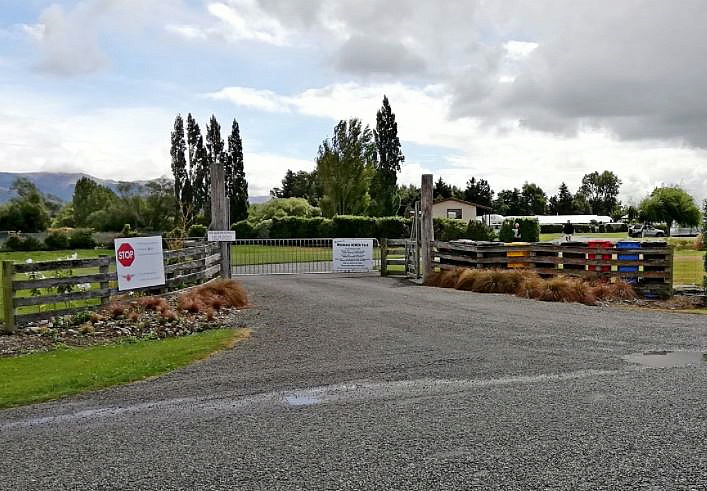
The park is laid out similar to a camping ground with well-defined spaces to set up camp. It’s sheltered and there is a good shed on-site for any gatherings. It gets a big tick from us.
Plenty of Walks
Right beside the NZMCA Park is Naylors Track. A walking track that follows the Waimate River. It is a relatively flat track that starts at Queen Street and goes through to Point Bush Rd (0.75km). From Point Bush Rd, you can continue on to Garlands Track (1km).
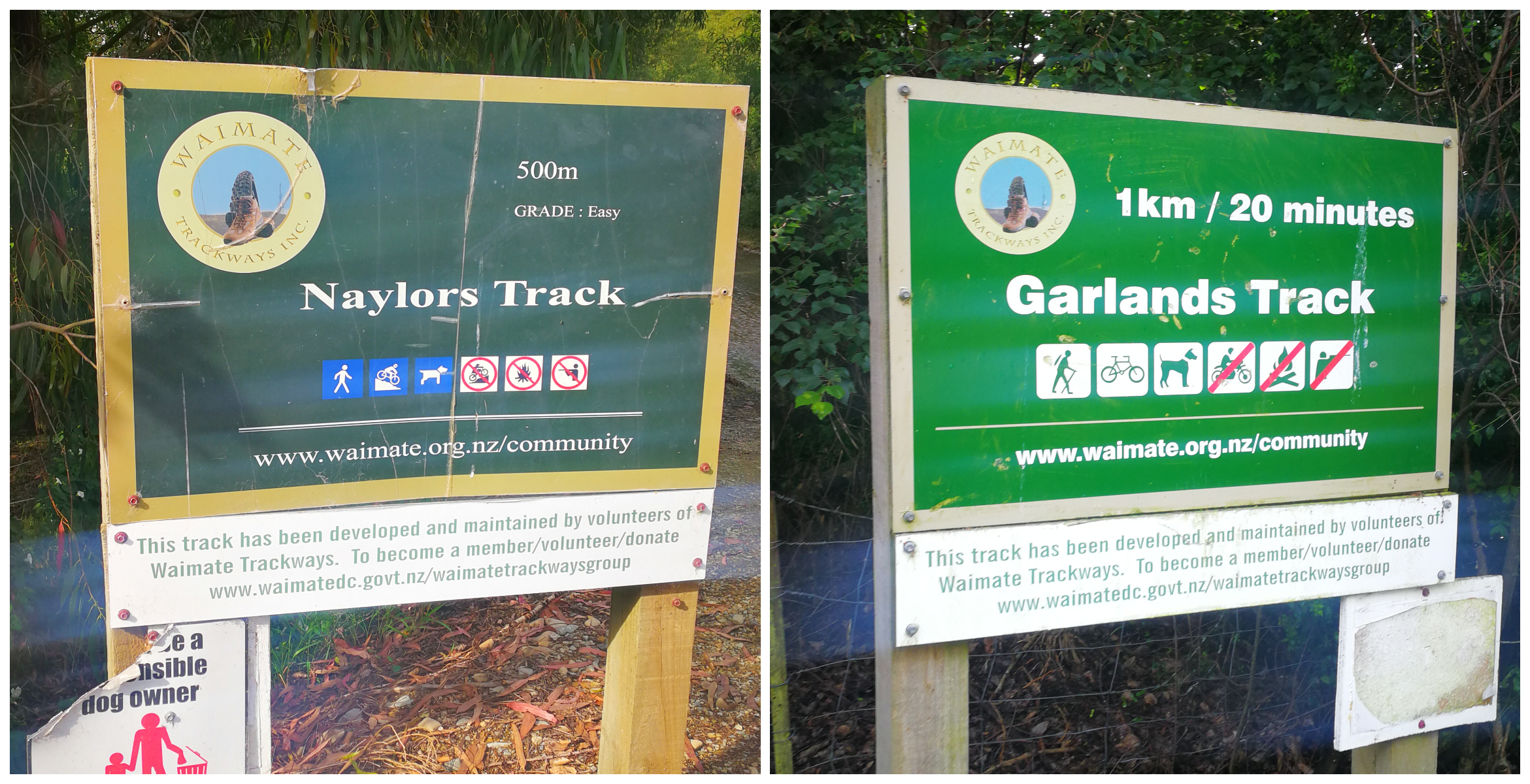
follow the signs to get from one track to the next
When you get to the end of this track, unless you want to get wet feet walking across a concrete ford, you need to do an about-turn and head back the way you came.
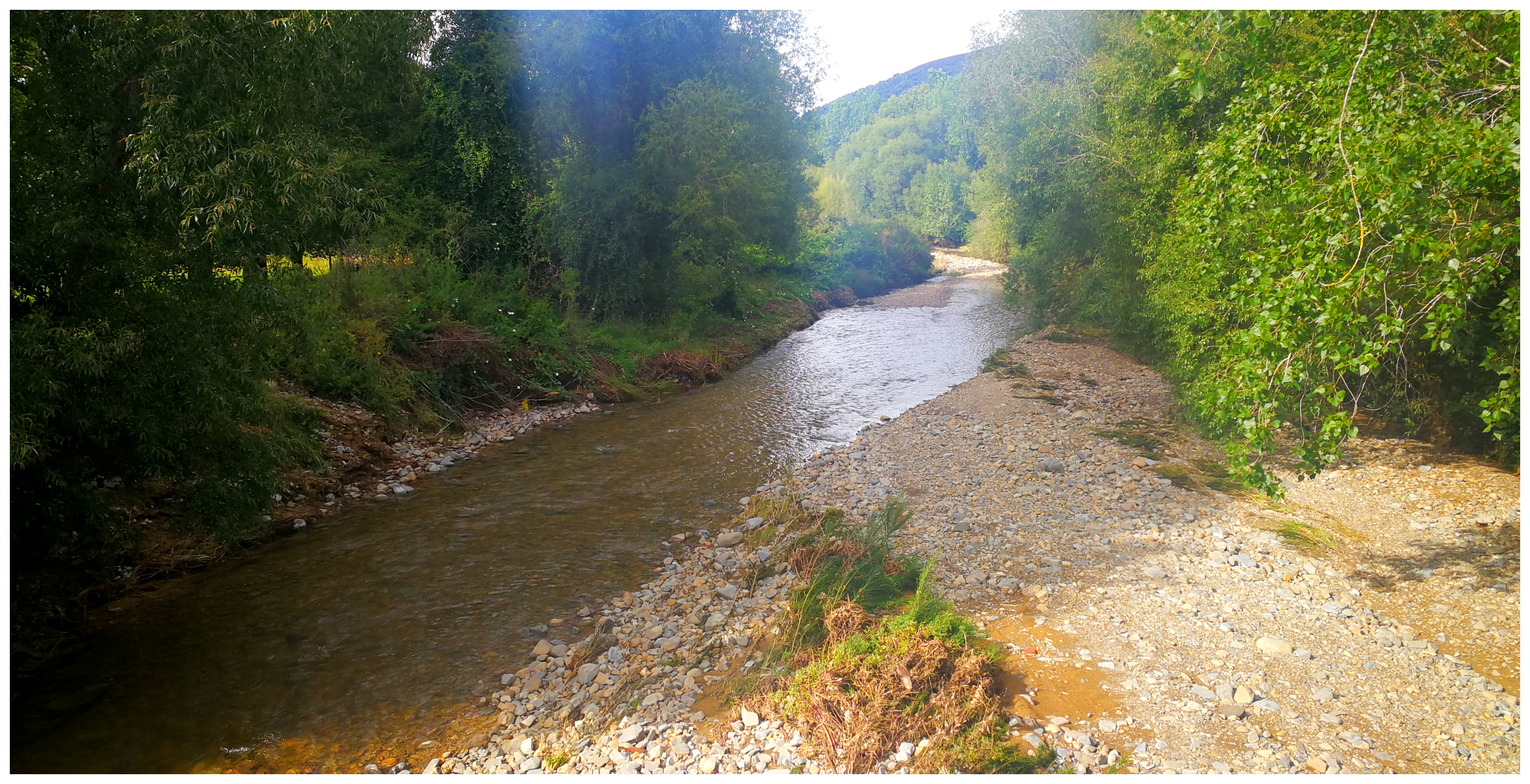
there are some very pleasant river views along the way
Victoria Park
Just down the road from basecamp, we found Victoria Park. It covers 6.8 ha and has beautiful gardens, trees and lawns. There are some animal enclosures, a cycling oval, a 9 hole Frisbee golf course, a playground and many places for sheltered picnics.
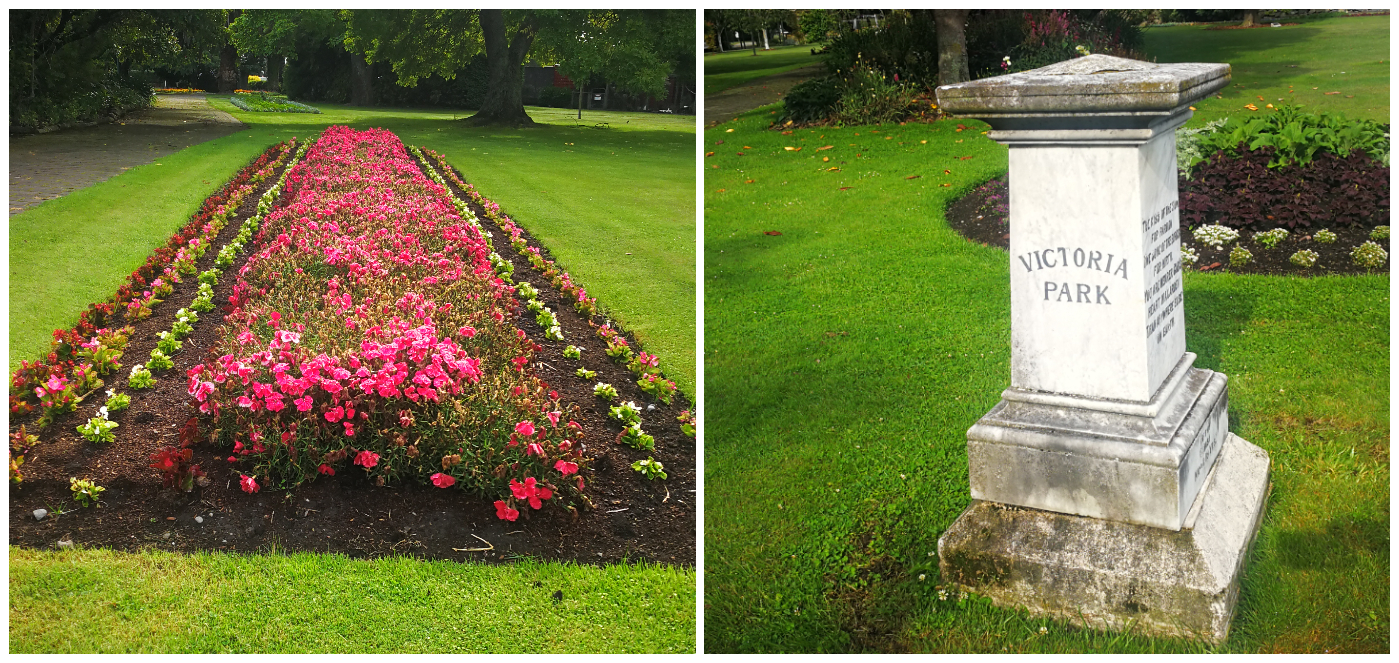
beautifully manicured gardens both laced with history and colour
It has been in situ since 1881 so it has been providing rest and relaxation for a long time. It was a nice detour to wander through whenever we walked to or from the town centre. There is also a camping ground located within the park grounds.
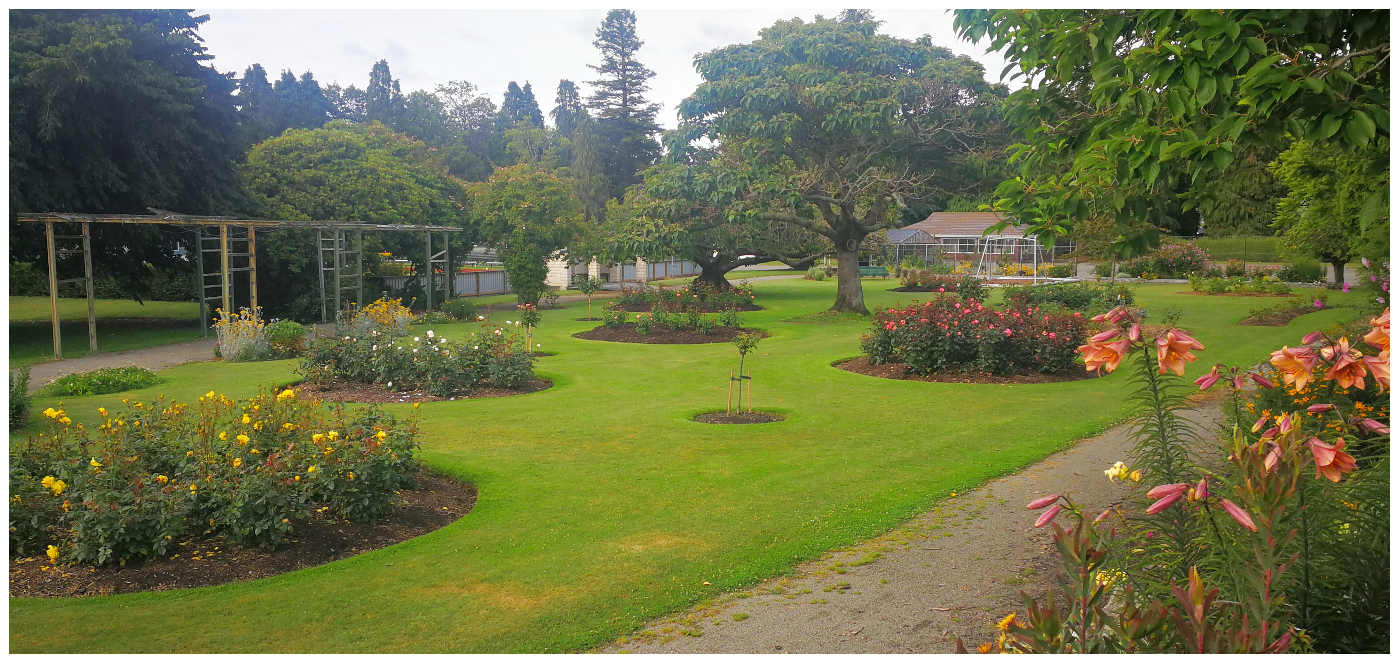
it is a peaceful oasis close to the town centre
Out & About
We continued our wanderings around Waimate, both on foot and by bike. Waimate is extremely flat so getting about is relatively easy.
It wasn’t long before we came across the famous Waimate Silos.
Silo History
It’s not hard to be wowed by the sheer scale of the impressive street art which adorns the towering grain silos in the main street of Waimate.
The silos were built by hand in 1920 and were actually the first of their kind in NZ. They are 36m in height and of an unusual design.
Unfortunately, inexperience with the construction, led to the grain not keeping particularly well. The silos were put to use too soon. The solid concrete base would have taken up to two years to dry completely. The dampness resulted in the grain going off. The venture was deemed a failure and the buildings and land were sold at a loss.
The silos were abandoned but resurrected for use in the 1960s.
Transport Waimate Ltd who own the land, was established in 1946 and is one of the longest-running businesses in the Waimate District. The company commissioned local artist Bill Scott to paint the four silos in 2018. There are also a number of other murals dotted around the town, painted by the artist.
Silo Art
The silos celebrate the town’s history and the figures depicted on them, helped shape the history that is now today’s Waimate.
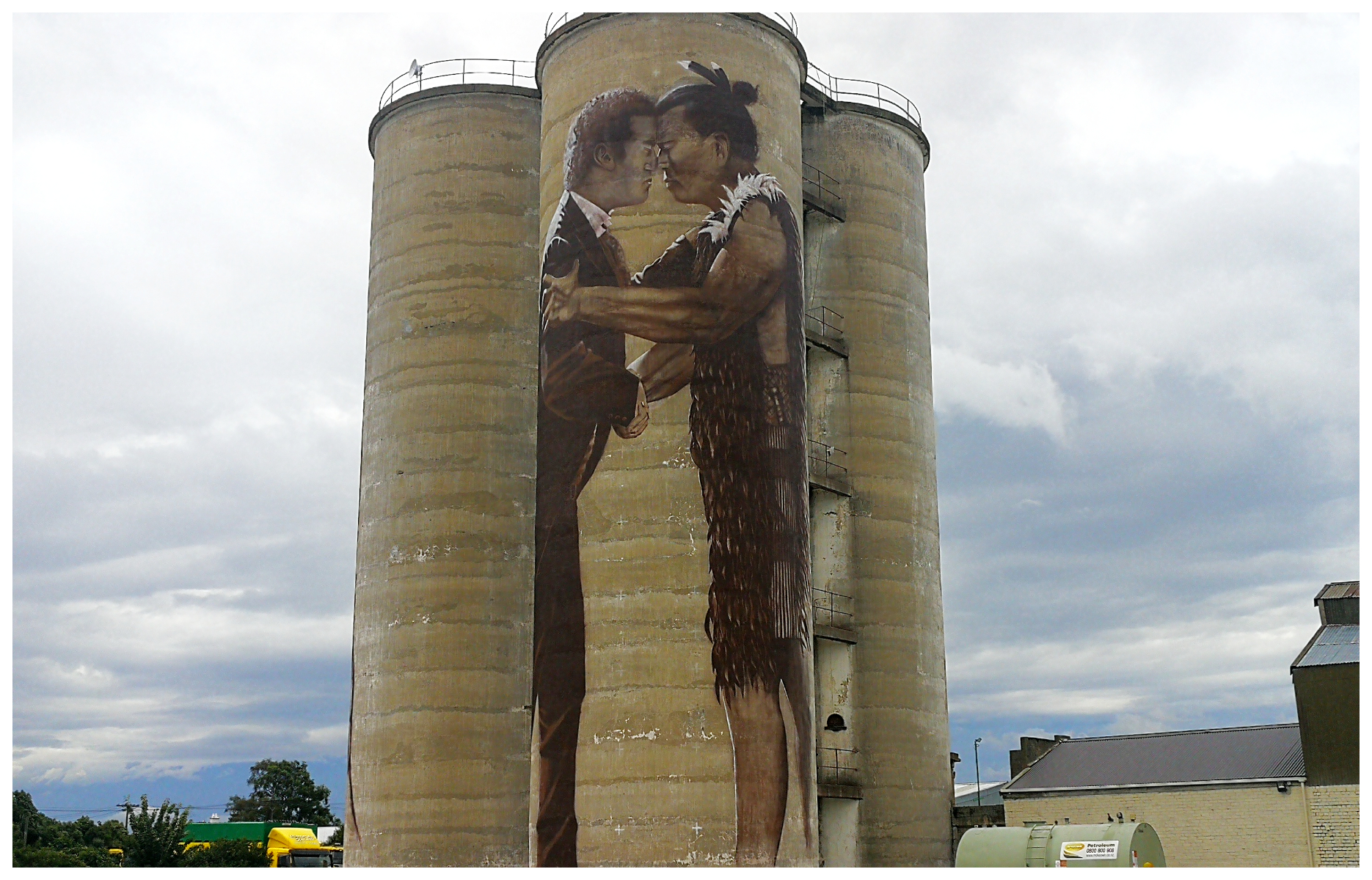
- Chief Te Huruhuru & Michael Studholme
The artwork sets the scene of the two greeting each other with a traditional Maori hongi. Michael Studholme was the first European settler in the area and met with Chief Te Huruhuru in 1854.
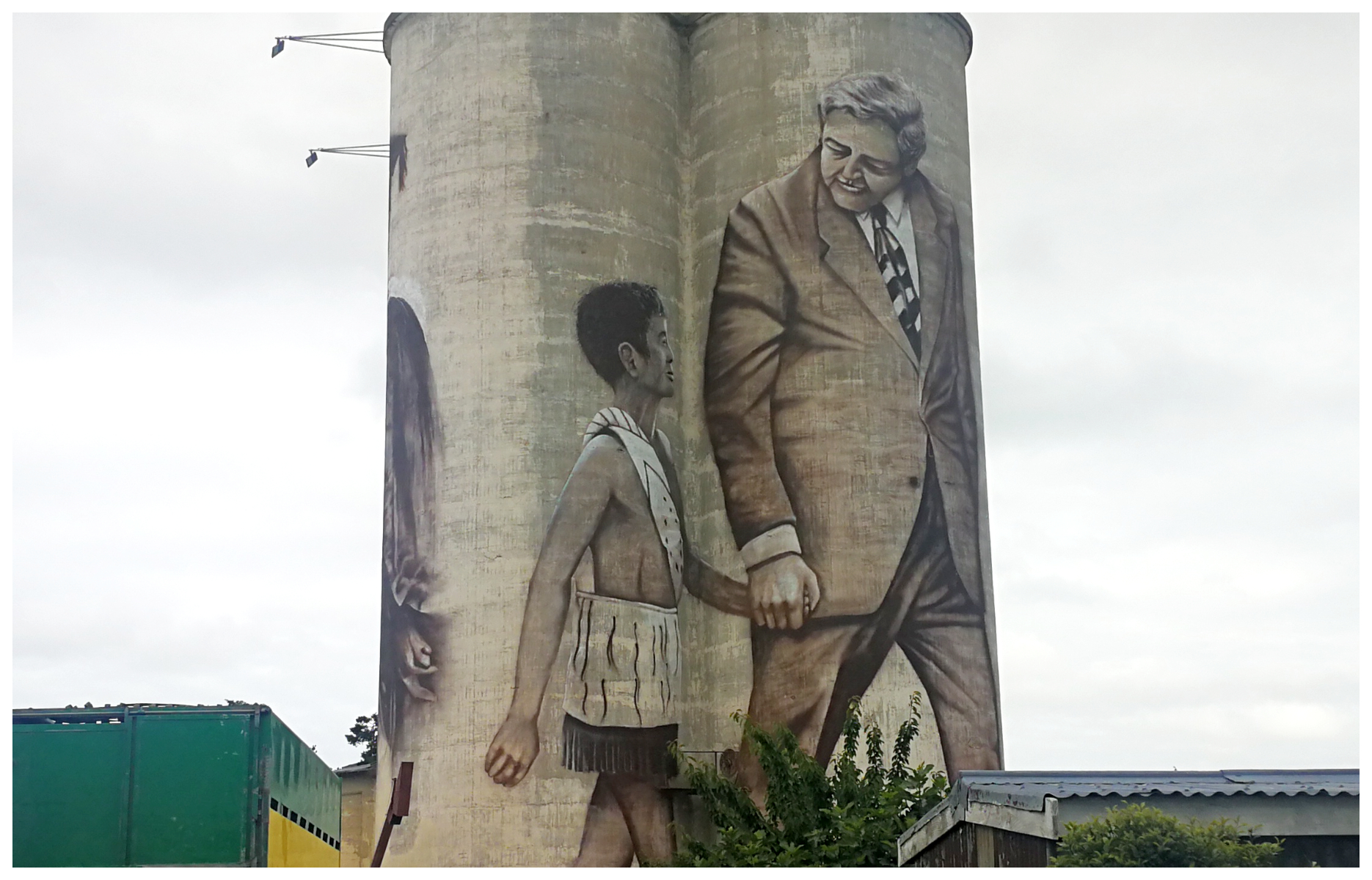
- Prime Minister Norman Kirk
NZ’s fourth Labour Prime Minister, Norman Kirk was described as a person of imagination, faith and energy. This scene recreates a scene between NZ’s 29th Prime Minister and a child at Waitangi.
Norman Kirk was born in Waimate in 1923. After his death, he was buried near his mother in the local cemetery.
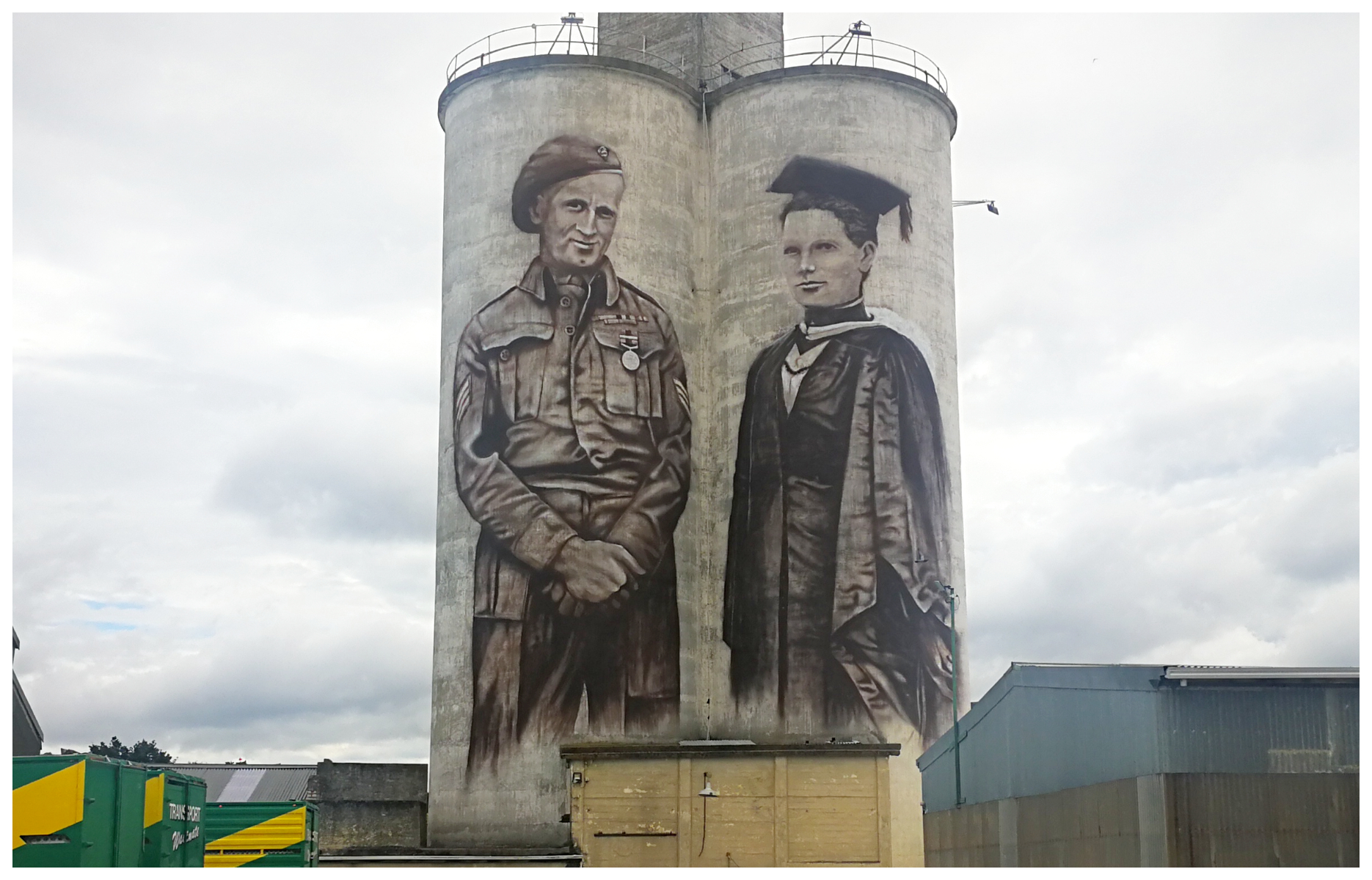
Eric Batchelor (left) – Dr Margaret Cruickshank (right)
- Eric Batchelor
One of the Allies’ greatest soldiers in WW II, Eric Batchelor was twice awarded the Distinguished Conduct Medal for bravery. Eric died in Waimate in 2010 after becoming a successful businessman after the war. Many members of Eric’s family still live in Waimate.
- Dr Margaret Cruickshank
The first woman GP in NZ who worked tirelessly during the Spanish Flu pandemic. Although Dr Mragaret Cruickshank was born in Palmerston, she worked in Waimate from 1897 until she fell victim to the very flu she had been treating her patients for.
Waimate Street Art
Following on with the whole ‘art theme’, artist Bill Scott has been busy in Waimate township, painting some pretty amazing street murals. Each telling a story of history that has shaped the town through the decades.

Mrs Stella Chamberlin and her washing
- Stella Chamberlin – located close to the base of the famous silos is a tribute to Stella Chamberlain who spent over 30 years washing the Waimate senior rugby jerseys (in a bath, by hand!). Stella was the first woman to receive life membership of the Waimate Rugby Club in honour of all her years of hard work

Bill Scott’s version of the March Hare
- March Hare – The March Hare is a character most famous for appearing in the tea party scene in Lewis Carroll’s 1865 book Alice’s Adventures in Wonderland. Bill Scott painted this mural on the wall of Waimate Motorcycles. The March Hare Rally is held in March (go figure!) in Waimate and attracts thousands of motorcycle enthusiasts from across the country

Waimate 50, an iconic event for the town, New Zealand’s Longest Standing Street Race, with a History that Dates Back to 1959
- Waimate 50 – The Waimate 50 mural is located on the corner of Queen and Paul Street’s and depicts the famous Waimate 50 Street Race. Bill Scott created the mural to commemorate this famous street race which draws crowds from all over New Zealand for a weekend of motor racing action.
Saturday Farmer’s Markets
If you ever find yourself in Waimate on a Saturday, then a visit to the Farmer’s Market in Seddon Park is well worth the trip into town.

the markets are certainly worth a visit and make sure you bring a bag for your eggs….lol
Although not a large market, the fresh veggies are well priced and plentiful. There are also some great examples of homemade arts and crafts on display and available to purchase.
We enjoyed a coffee from the coffee cart whilst sitting on the steps of the Band Rotunda (which was built in 1911).

the historic bandstand made a great coffee stop
We cycled back to basecamp with our small packs filled with fresh veggies and I made Scotty nurse a dozen free-range eggs. I’m happy to report that no eggs suffered any damage on the ride back and all remained intact.
Knottingley Park
We cycled a couple of kilometres out of the town centre, to Knottingley Park and Abortorium. It is a beautiful and peaceful park set on 36 hectares.
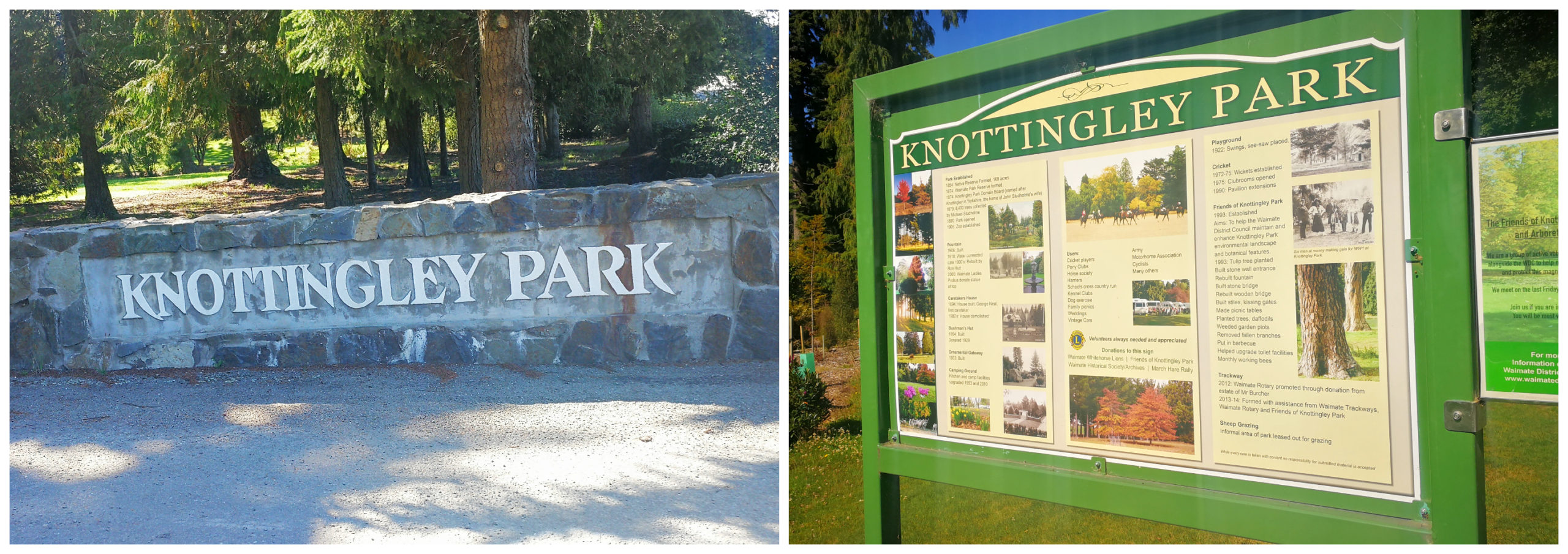
the grand entranceway to the park and the signage and history board at the start of the tree trail
We cycled around the camping ground located on-site and continued along the Tree Track which took us past some of the 3,000 old exotic trees planted there. It is believed that the first tree was planted in 1878.
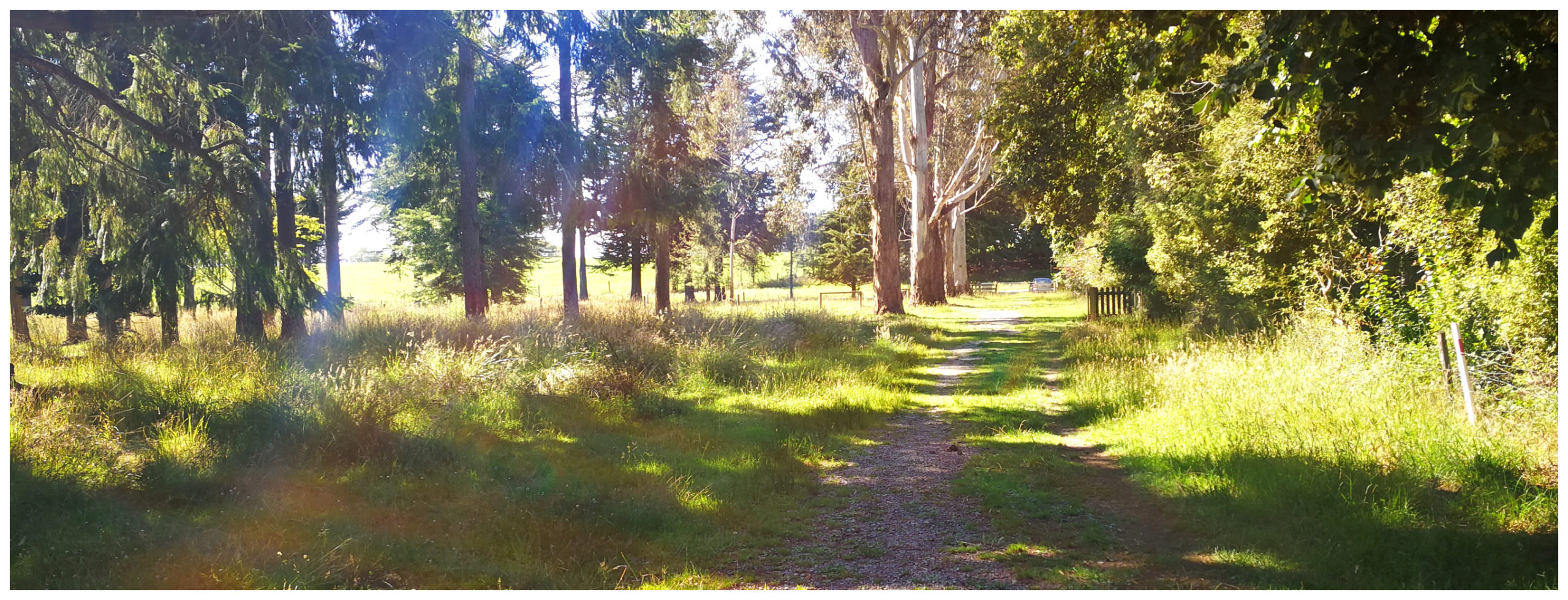
part of the tree-lined track around the park
The cricket ground located within the park recorded its first match in 1902 between South Canterbury and North Otago.
We also discovered the replica of an early bush hut built in 1864.
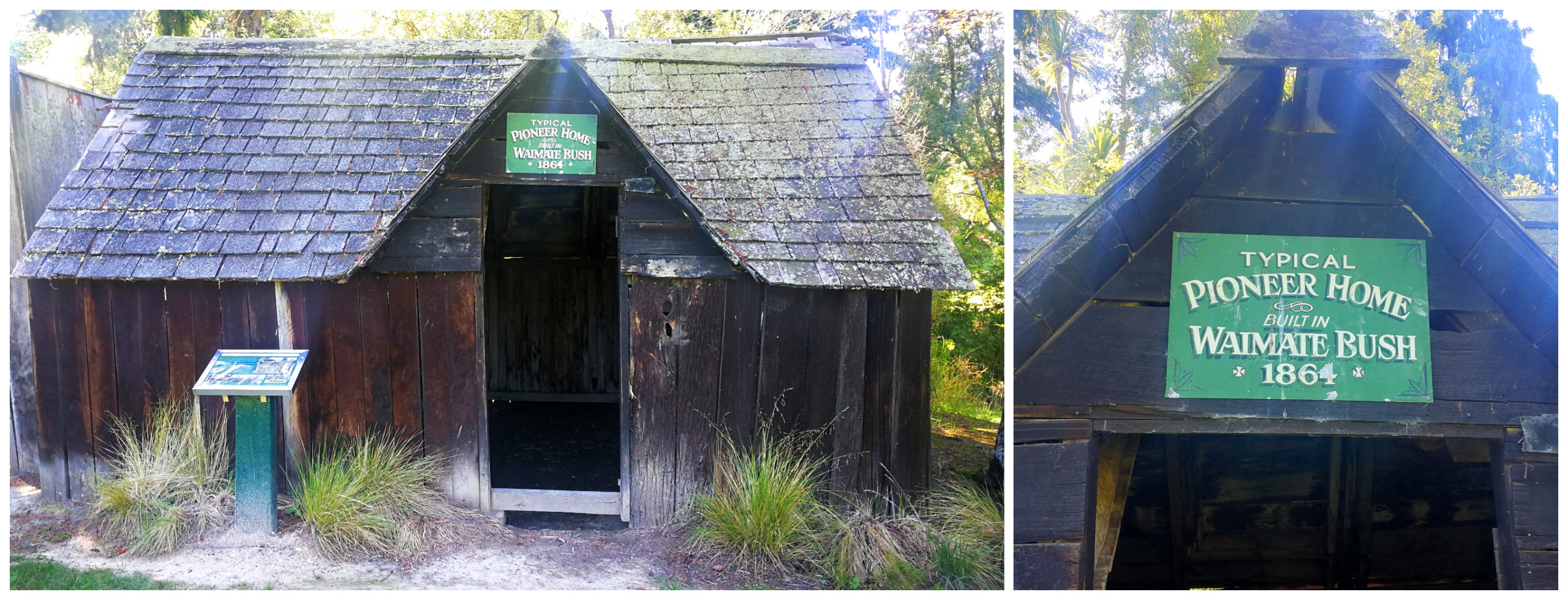
the scant dwellings of the bushmen that used to work the timber trade in the surrounding areas
The White Horse Monument
It’s hard to miss the White Horse Monument located high up on the hill behind the town.
There are a couple of ways to get up to the monument. A walking/mountain bike trail or there is a road that will take you to the summit (a much easier option!).
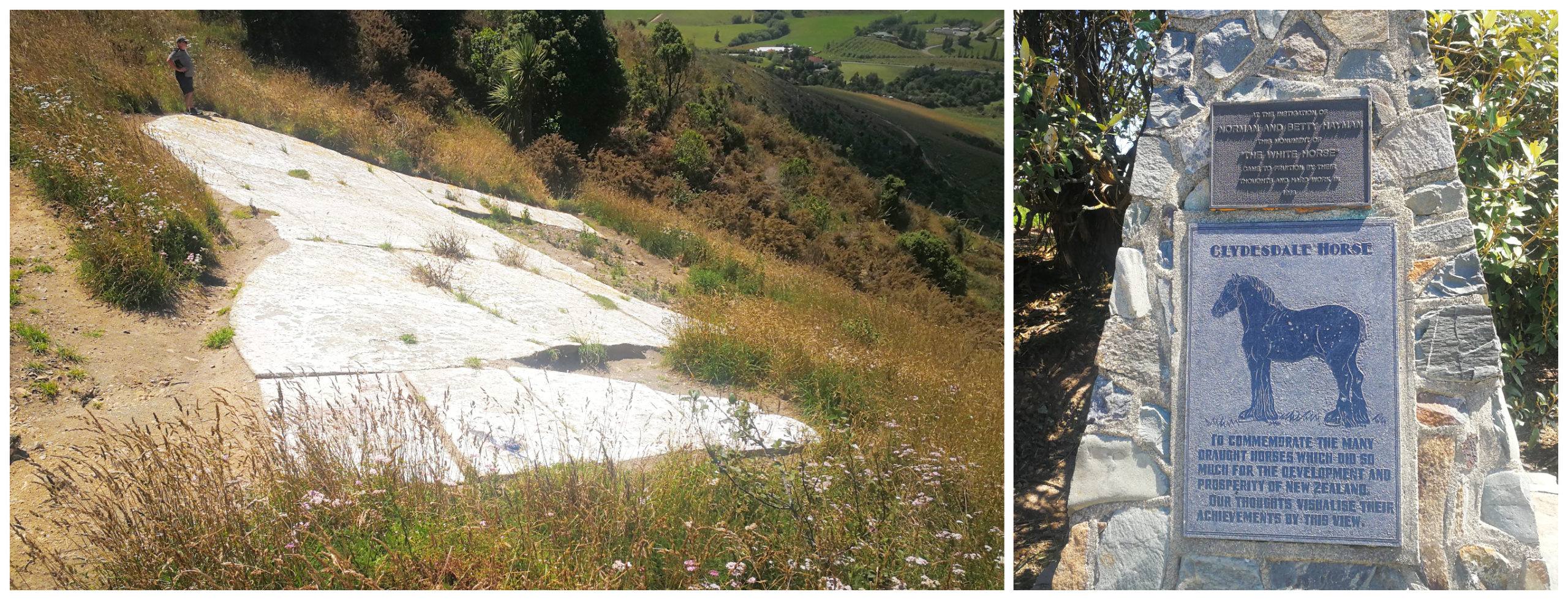
The White Horse Monument can be seen for miles around
We opted for the easy route and jumped in the ute to get to the lookout to view the monument.
It commemorates the Clydesdale horses that helped break the land in. The monument was constructed in 1968. It took 3 months to lay the 1220 concrete slabs. The head of the horse was pre-cast in a local yard.
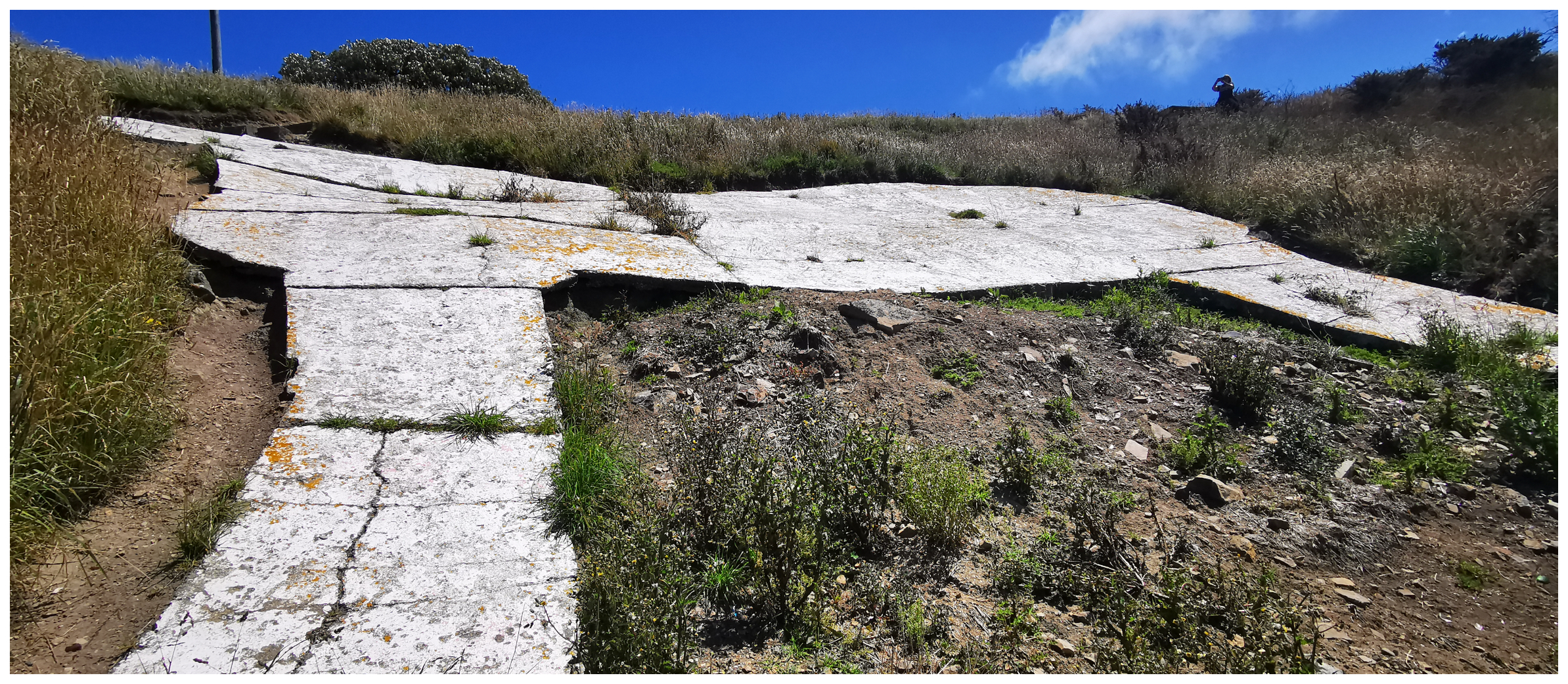
it is extremely tricky to get a photo up close – best view from afar

photo courtesy of the Waimate District Council
Records show that it cost $240, met by donations from ‘old time’ farmers, teamsters, and others who admired the Clydesdale horse.
The views from the top of the lookout are amazing. The weather was perfect allowing us to admire the panoramic views that stretched out towards the Pacific Ocean.
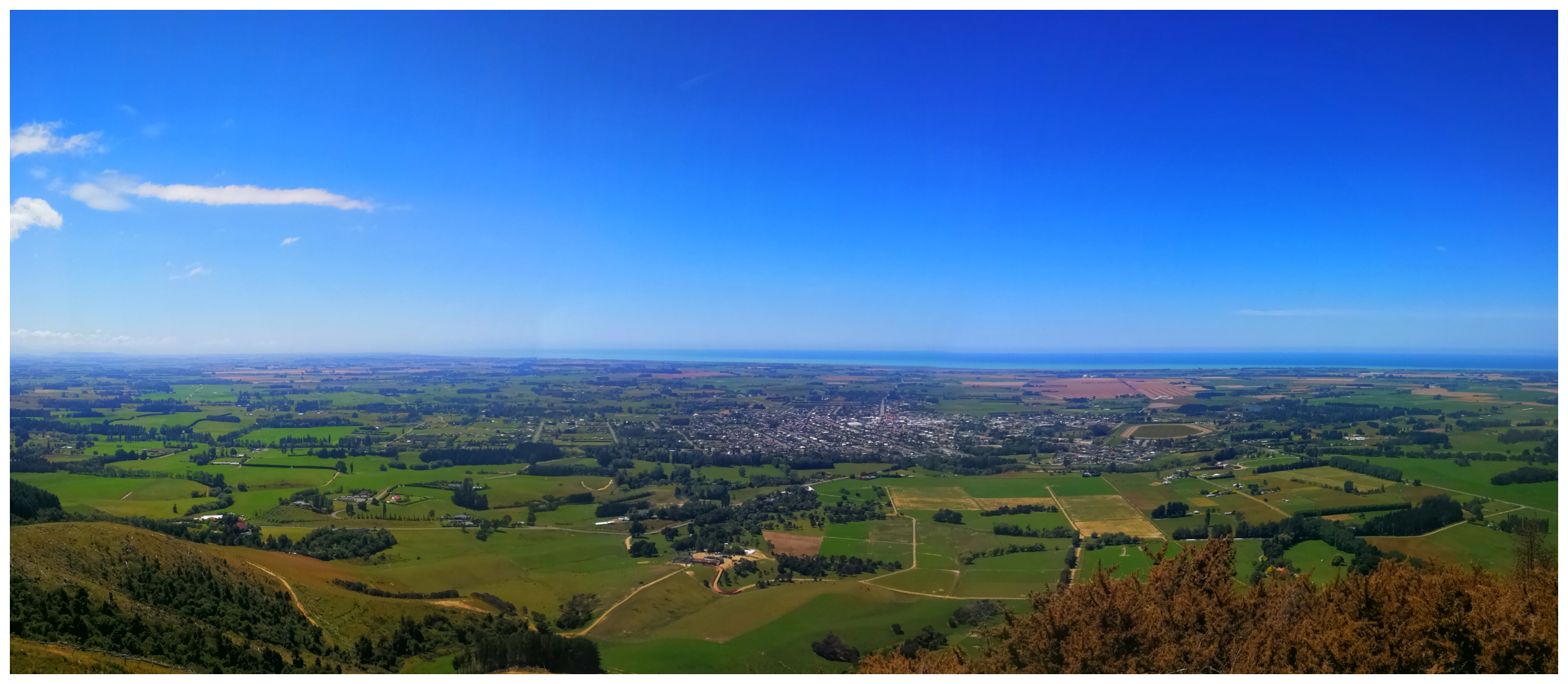
our views from the White Horse Lookout, across Waimate to the coast

The Gallipoli Lone Pine lives on……On August 28 2015, the Waimate RSA held an event to plant one of 50 seedlings from the original Lone Pine in Turkey. It grows proudly on the hill just behind the White Horse monument
Waihao Forks Hotel – Ted’s Bottle
Travelling along SH82, 12km from Waimate we arrived at the unassuming Waihao Forks Hotel. This is the home of “Ted’s Bottle”.
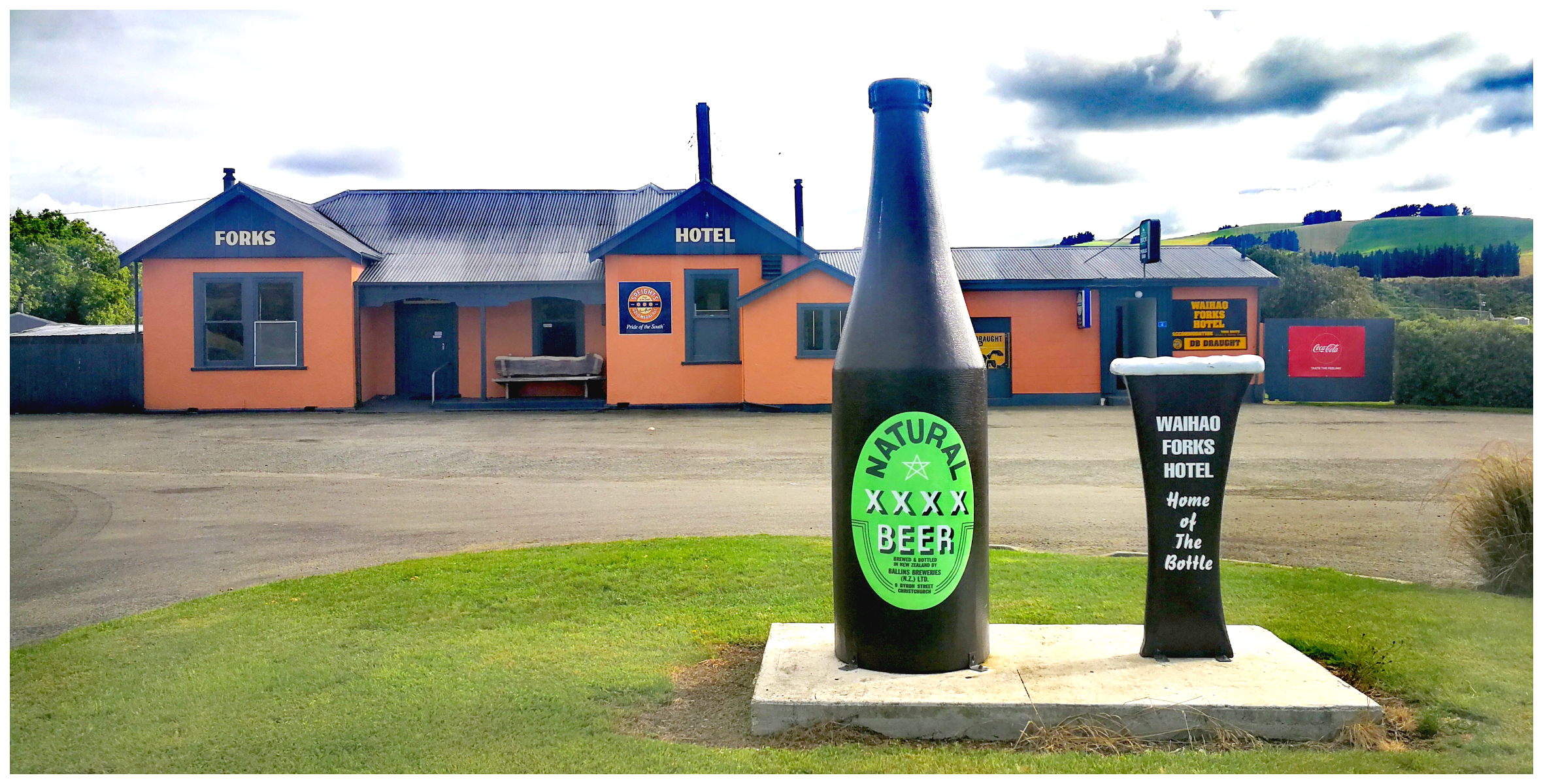
the railway tracks used to run close to the Waihao Forks Hotel entrance, now the road offers a different transport option than back then
Every Anzac Day, while New Zealanders gather at memorials, the Waimate RSA members gather here at the Waihao Forks pub to stand solemnly in silence for a moment before an unopened beer bottle.
“Ted’s Bottle”, in fact, has become a memorial for all the NZ men and women who lost their lives while serving overseas.
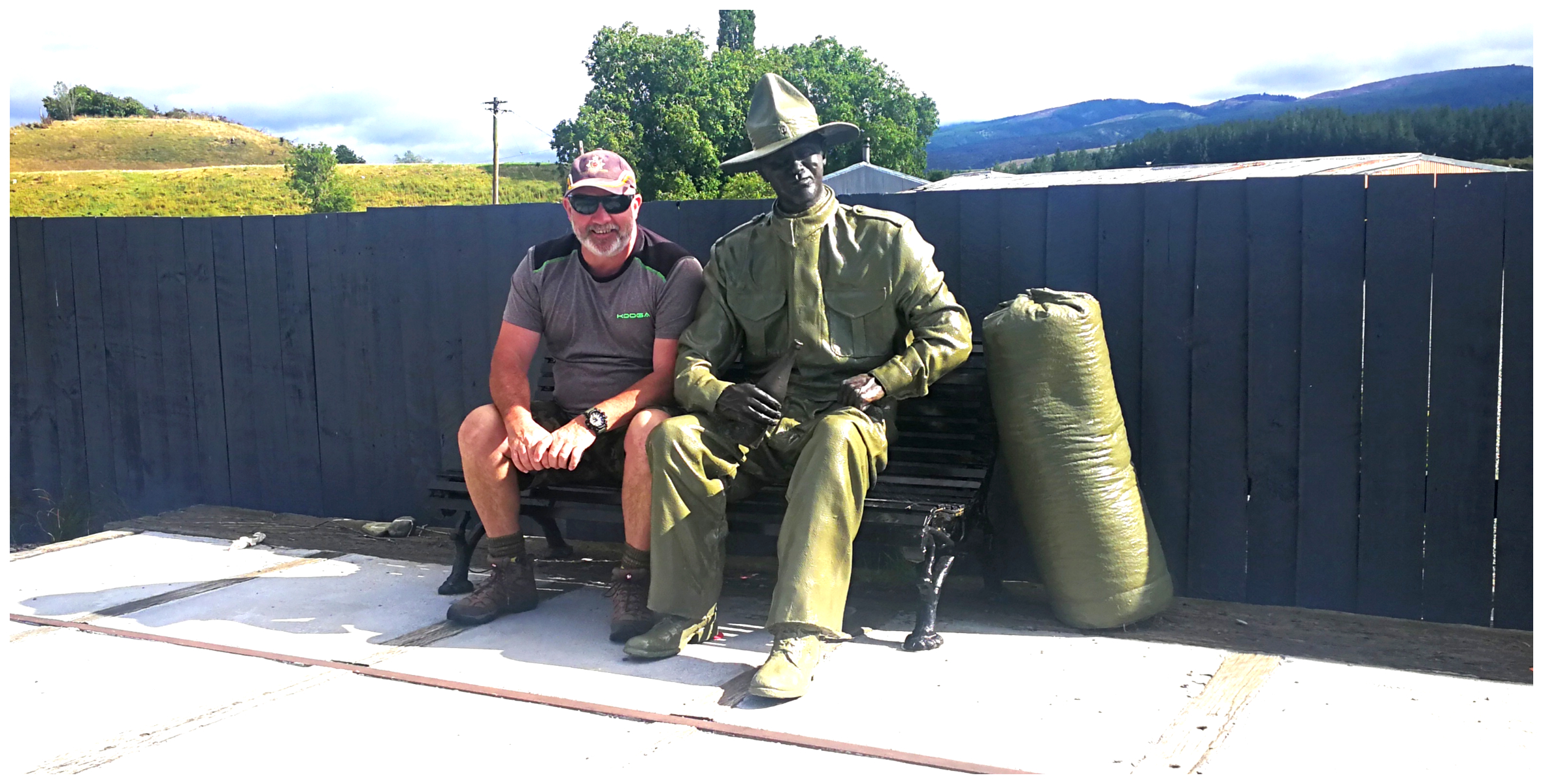
Scotty thought he’d spend some time with Ted while he waits for his train
A small group of locals (including Mayor Rowley) commissioned the life-sized sculpture. The former Oamaru-based artist Donald Paterson has created the sculpture.
Ted……Who Was He?
Ted (Edward D’Auvergne), a local farmer was a ‘likeable larrikin’. He enlisted to fight in WWII and was due to depart Waihao by train to start his training before leaving for overseas.
There are a few versions of how the unopened bottle came to be enshrined in a glass box. Standing ‘pride of place’ behind the bar.
I kinda like the version that goes something like this:
On 27 December 1939, the publican (George) of the Waihao Forks Pub, invited Ted to have a farewell drink before boarding the train. When they heard the train whistle in the distance, George put a second bottle on the shelf saying “Ted, we’ll have this one when you come home again”. He never came back and lies buried in a Crete cemetery.
His bottle is still at the pub, on the shelf, unopened.
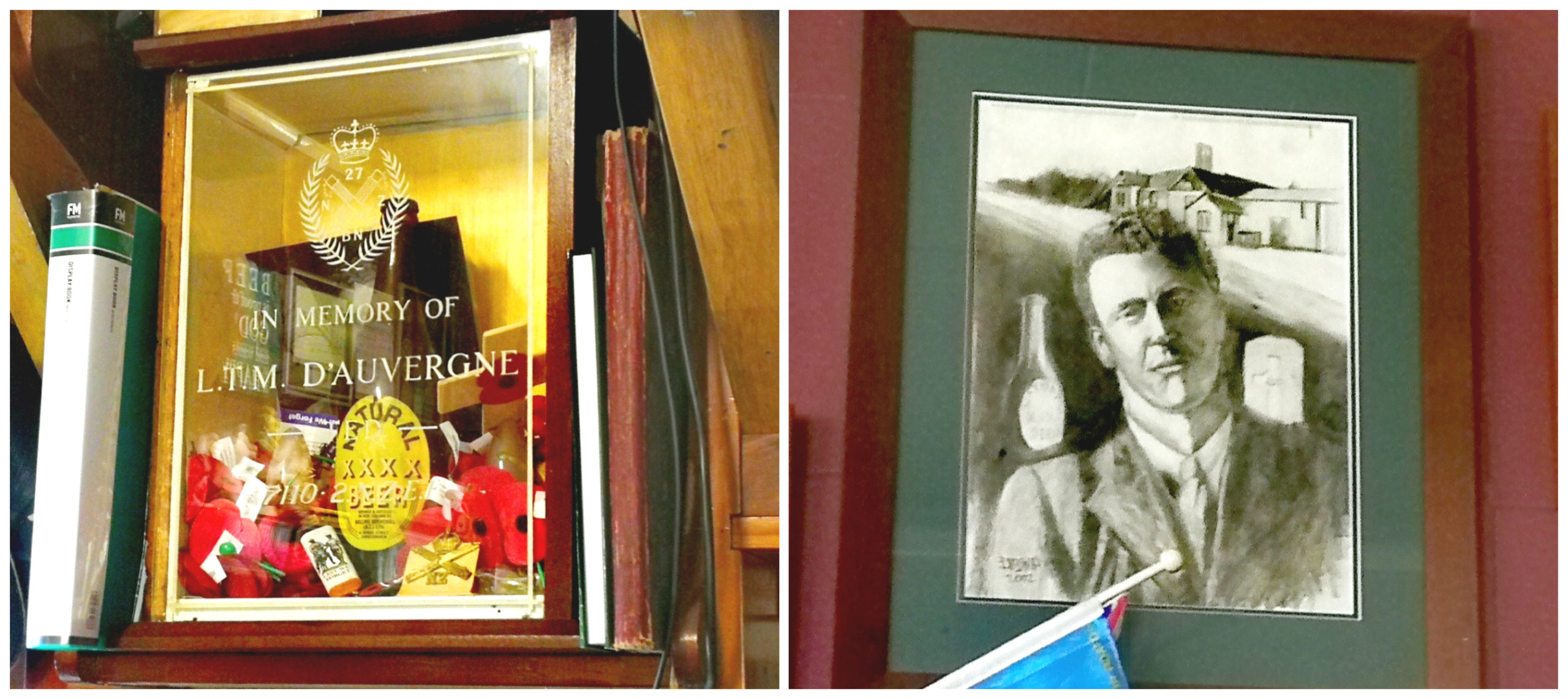
the unopened bottle, encased in a glass case and a portrait of the man himself
It only seemed right, that we raise a glass in memory of Ted and all those that never came home – “Cheers Ted”.
Driving the Hakataramea Valley
It was time for a bit of a ‘roadie’. We’d been doing some research on driving the Hakataramea Valley with the caravan in tow.
While we were staying at Waimate, the road to Kurow was still closed due to a large washout that had occurred during some heavy downpours a couple of weeks beforehand.
Not to be deterred, we left the caravan at base camp and headed towards the Meyers Pass in order to get to the Hakataramea Valley.
Meyers Pass Road
Meyers Pass Road is located inland from Waimate and is gravel nearly all the way through. It is very windy in places with some sharp bends and a number of fords. All of the fords were okay to cross. A large number of them were dry but bumpy so we had to pick our way carefully.
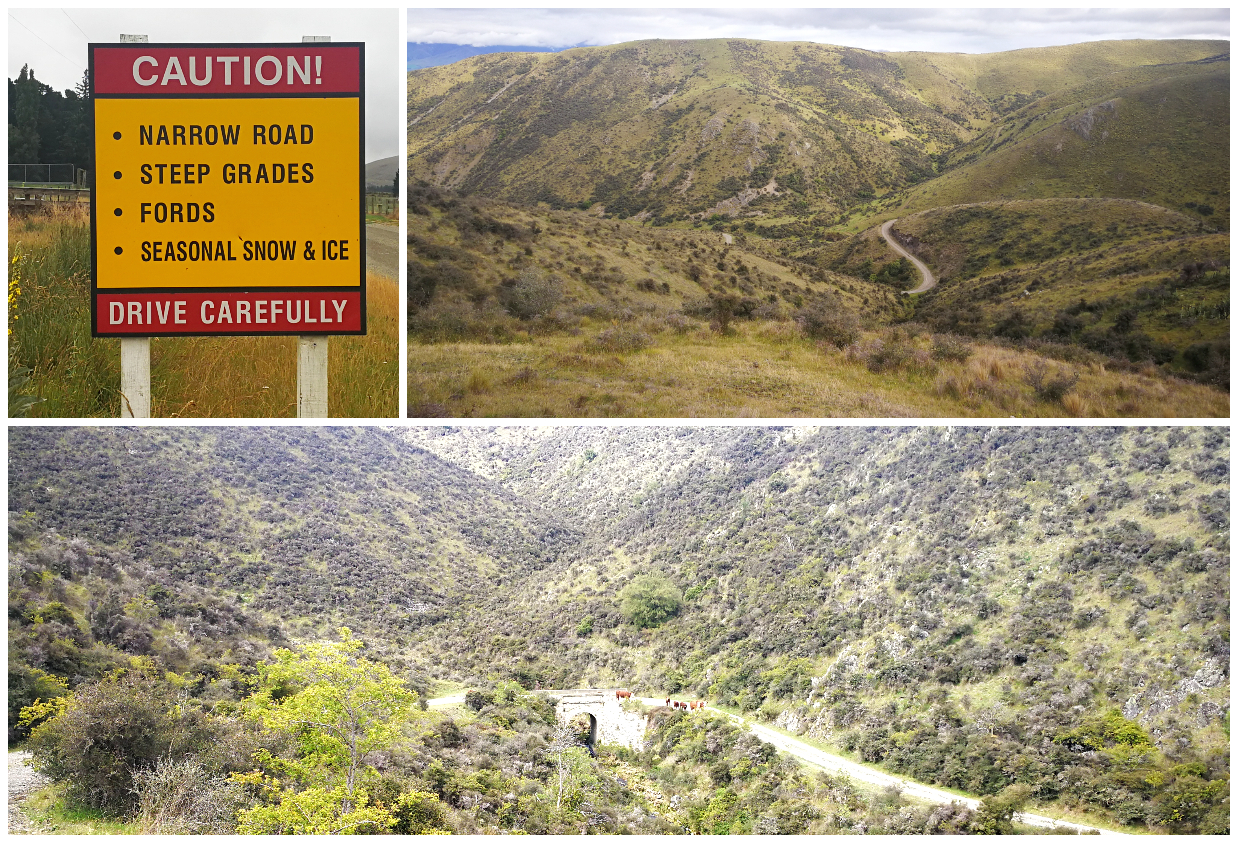
the warning sign at the start of the Meyers Pass, and the winding road which would take us through the Hunter Hills, stopping for a view down to the historic bridge and some cattle we had to share the road with
There is a warning sign at the beginning of the actual pass. The nominated gate opener (usually the passenger) has to be prepared to open and close approximately 8 gates. If you strike it lucky, some will be already open for you.
We navigated the Pass through the Hunter Hills. Steep hillsides coated with snowgrass and tussocks. The odd Cabbage Tree Groves are the last stands of the forests that inundated the Waihao earlier in the 19th century.

a close up of the old bridge, still in good order (thankfully)
Halfway through the Pass, we stopped at the historic stone bridge. Constructed in 1879, it crosses Sisters Creek. It has stood the test of time very well, reinforced with concrete in 1917.
Condition of Road
Although gravel, the road surface was good with minimal corrugations. I would recommend that this route would be a ‘fair weather’ option. Due to the higher altitude and risk of snowfalls, best not attempted in winter.

make sure to pick the right spot to cross
Larger rigs with minimal clearance would struggle with some of the tight corners and rough ford crossings so traverse at your own peril. Also, note that there not much in the way of cellular phone coverage if you come to grief. If you are wanting to drive Meyers Pass in a motorhome or towing a caravan, it would be advisable to travel in pairs for extra safety.
Hakataramea Valley
After coming out of the Meyers Pass, we dropped down into the beautiful Hakataramea Valley. The Hakataramea River joins with the Waitaki River and blends in with the south Canterbury high country mountain landscape.

the sign has clearly had a hard life, the boundary between Waimate and Mackenzie Districts (note the spelling on the sign “Mackenze”……typo maybe?)
The driving was a lot smoother and flatter after having traversed Meyers Pass Road.
Sheep farming is the main activity for the area. Three early sheep stations dominated the area. Hakataramea Station, Hakataramea Down Station and Station Peak.

the weather had set in as we traversed the Hakataramea Valley
Hakataramea became a rail terminus in 1881. Neighbouring Kurow grew quicker than Hakataramea. It never developed beyond a small settlement.
Mackenzie Pass
The Hakataramea Pass leads into the Mackenzie Pass.
It bears the name of James Mackenzie. In 1855 he was captured with 1,000 sheep which he stole from the Rhodes brothers’ Levels run, on the western side of Mackenzie Pass.
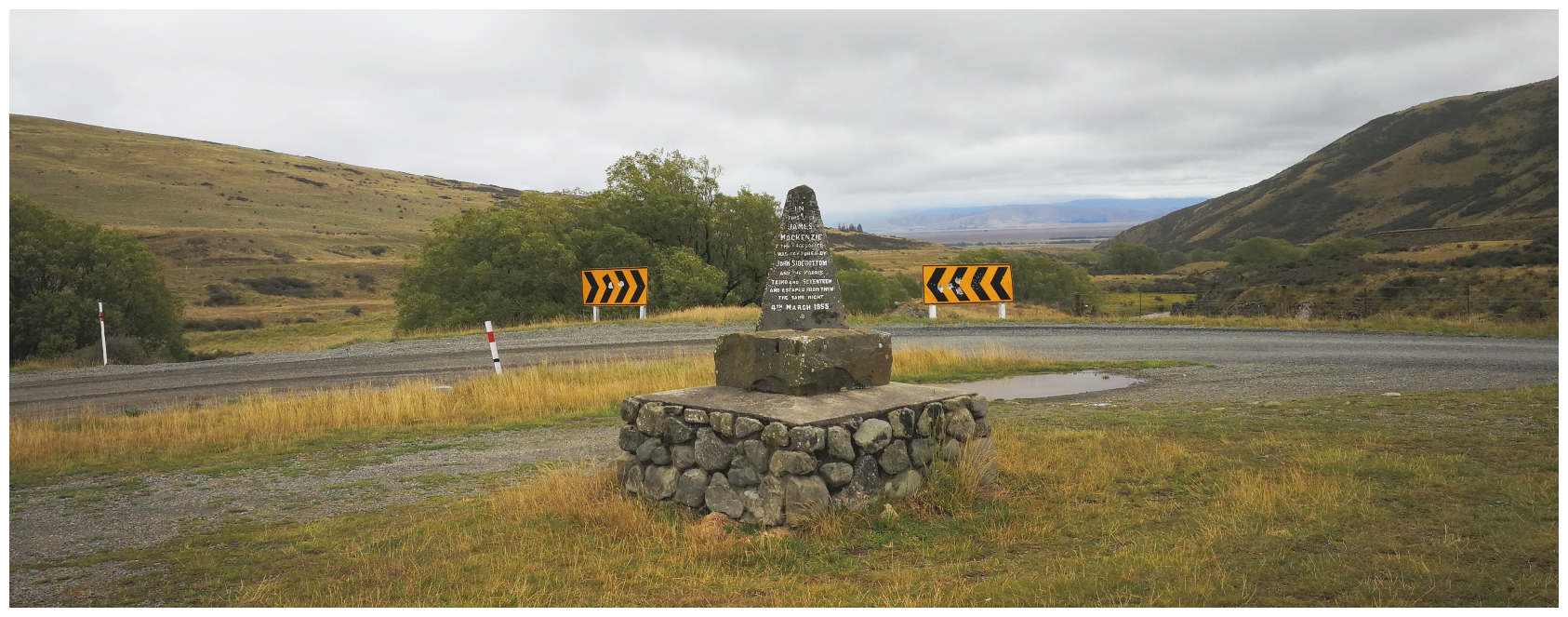
the monument marks the spot where James Mackenzie was caught with 1,000 sheep
We stopped off at the stone monument. Mackenzie was apprehended close to where this monument is situated. Many places are named after this sheep rustler, quite bizarre.
The memorial is quite unique in the fact that the inscriptions are in English, Gaelic and Maori. It was in fact two Maori shepherds that managed to track and find the stolen flock at this spot where James Mackenzie’s escapades came to an abrupt halt.
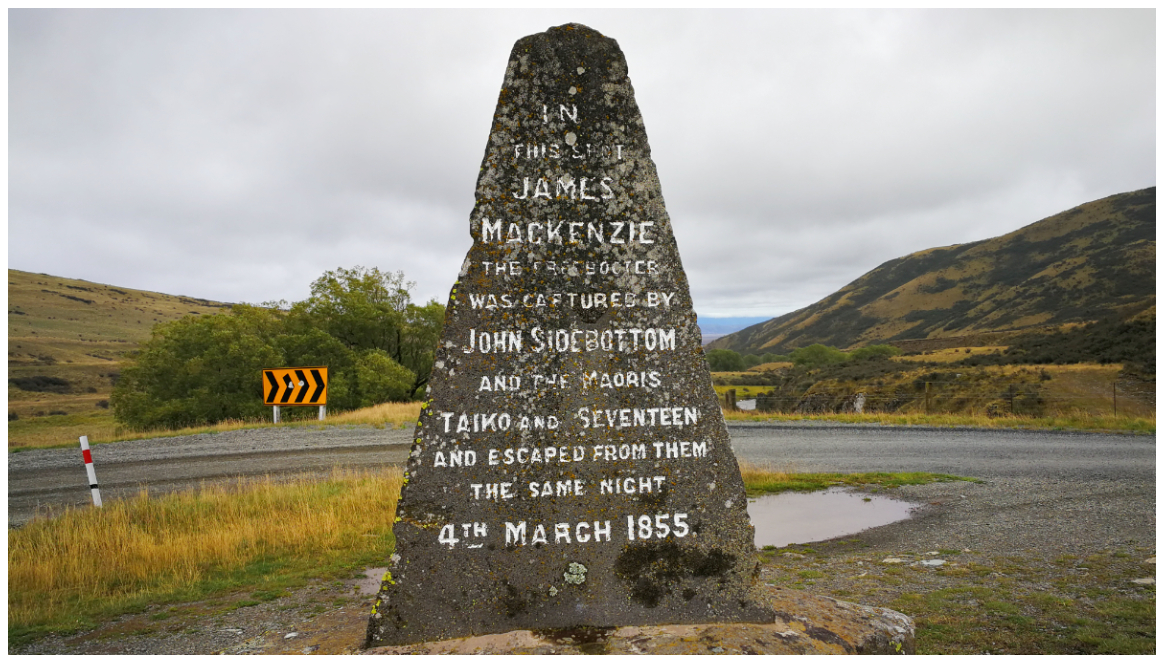
the English version of the inscription on the monument
Rather than continuing onto SH8 at Burkes Pass (which is an area we have already explored), we turned onto Haldon Road which would take us through Albury and onto Pareora (SH1).
St David’s Pioneer Church, Cannington
Before heading back to base camp at Waimate, we stumbled across St David’s Pioneer Church at a small settlement called Cannington, a short distance from Cave.

the beautiful church – St David’s Pioneer Church
Andrew and Catherine Burnett worked the Mount Cook sheep run in 1864. Built by the Burnetts’ son Thomas, who became a Member of Parliament. An impressive memorial to his parents and all runholders, shepherds, drovers, shearers and other workers on early high-country runs.

the intricate stained glass windows compliment the stonework surrounds
Construction began in the 1930s. Built of uncut glacier-born boulders from near the Burnetts’ Mt Cook homestead. The floor, ceiling and pews are made from Totara and beech. No nails were used to construct the church.
We enjoyed the church’s architecture from the outside only as the doors were locked.
Burnetts’ Homestead
Across the road from the church, there is a very eye-catching grand gateway. This is the entrance to one of four farms of the Burnetts’. Strath Naver takes its name from the Naver river in the Sutherland Highlands.
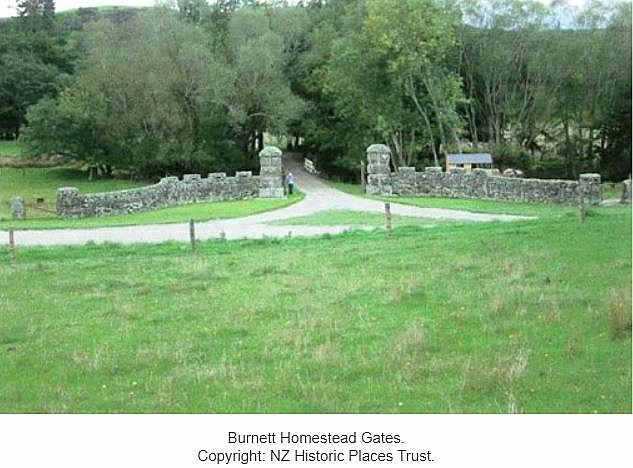
St Andrew’s College, Christchurch, uses the property for agricultural training purposes.
That concluded our rather long ‘roadie’, our trip of discovery of both landscape and history. Just how we like it.
“Our recommendation is to definately put Waimate on your list of places to visit. Stay, play and explore”
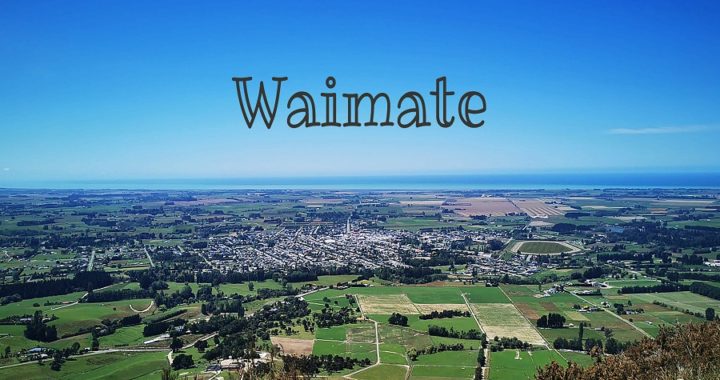
What a pearler of a blog post and accompanying photos. A very interesting read indeed. Thanks so much for all your efforts to share your journey. Ps. What type are your e-bikes?
Oh thank you so much Kevin. Our e-bikes are Specialized Levo. Love them. Just got them before Xmas.
Fantastic blog. Thank you both. I can’t believe we missed the March Hare. Keep these great blogs coming. Chris & Murray (limes)
Thanks guys, oh and I do miss your limes….lol.
Hi Linda. Very good summery of Waimate & the surrounding areas. Althogh bought up in Central Otago we did high school at Timaru & laterly farming in Sth. Canterbury before ‘flying the coop’ to Aust. So know the area well. I enjoy your articles as it gives me trips down memory lane. Keep up the good works
Oh thanks Geoff, I’m glad my blogs conjure up a few happy memories for you……more in the pipeline. Linda
Thanks for sharing and taking us to all these amazing places with you. Whilst I would love to visit many of them a campervan not quite the ideal vehicle, but will certainly be attempting many – one day!
Thanks Gill, glad to provide you with places to put on your ‘List’.